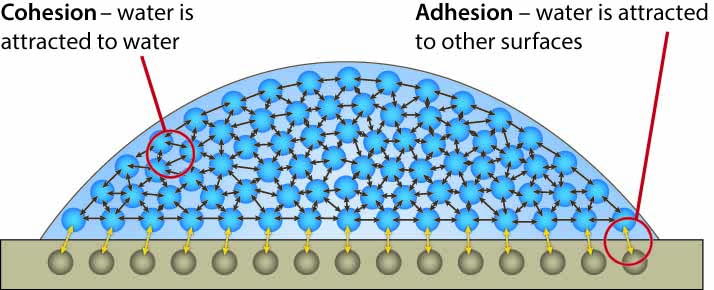Soil surfactants are proven to overcome soil water repellency, but how do they work?
Related Articles
Hydrophobicity or soil water repellency is a naturally occurring phenomenon, and one that all turf professionals struggle with from time to time. When we think about water repellency, it is important to first understand the properties of the water molecule, and the forces that govern its behaviour.
While a water molecule has no net charge, it is a strongly polar molecule in that it carries a partial positive charge near the hydrogen atoms at one end and a partial negative charge near the oxygen atom at the other. This polarity is what allows water molecules to interact with each other and other surfaces.
There are two main forces that govern how water behaves – cohesion and adhesion. Cohesion is the strong attraction of the water to itself, forming surface tension. Cohesion is what makes water form droplets and is what allows a dragonfly to land on the water’s surface without breaking through. The other force, adhesion, is the attraction of water to other surfaces and essentially what makes things ‘wet’. It is the balance between cohesion (water molecules pulling toward themselves) and adhesion (water molecules being pulled toward other surfaces) that determines the degree of wetting that can be achieved.

In a wettable soil, the adhesive forces pulling water molecules to the surface of the soil particles are stronger than the cohesive forces holding the water molecules close to each other. This allows water to spread through the soil for greater moisture uniformity and availability to plant roots. Soil water repellency occurs when soil particles become coated in a waxy residue, often the result of activity from microbes and organic matter. This coating interferes with the adhesive properties of the soil particle, so that cohesion of the water becomes the stronger force; the water molecules cling tightly to each other and can no longer be effectively pulled to the soil through adhesion. This can make it very difficult to get water to infiltrate into the soil and almost impossible to create uniformity of moisture through the profile.
A surfactant molecule is cleverly engineered to have both a hydrophobic part (water repellent) and a hydrophilic part (water loving). The hydrophobic part attaches itself to the hydrophobic coatings on the soil particles and the hydrophilic part attaches to the water molecule, acting as a bridge between the two – once again encouraging water to move through the soil profile more uniformly.
Aquatrols has led the way with surfactant technology since developing the first commercially available soil surfactant in the 1950s. Utilising over half a century’s experience in surfactant formulations for the management of water movement and plant health, Aquatrols launched Zipline in 2018. Zipline is a blend of two high performance chemistries to aid in water management, combined with AquaVita Technology. The soil surfactants in Zipline break surface tension and optimise the moisture deep down in the soil profile. Once in place, the AquaVita Technology helps to maximise turf quality by enhancing the availability and retention of both applied and existing nutritional elements. With its ability to promote balanced hydration and unlock bound nutritional elements, Zipline delivers fast, firm turf with consistent results on all turf types. The variable application rate of 6L – 25L per Ha ensures that there is a rate to suit all users for any turf area including greens, tees, fairways, pitches, stadiums and more. Zipline is best used as a part of a programmed approach to water management.
There is no better time to contact your Aquatrols territory manager to find out more about Zipline and proactively treat hydrophobicity before it becomes a problem.
For more information, visit eu.aquatrols.com

























